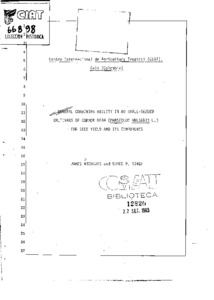General combining ability in 80 small-seeded cultivars of common bean (Phaseolus vulgaris L.) for seed yield and its components
Increase in yield potential of dry common bean (Phaseolus vulgaris L.) cultivars has been either imperceptible or small and gradual, in spite of large variation of most traits, including seed yield. Therefore general combining ability (GCA) of 80 cultivars and lines was investigated. Eight sets of 10 entries each were used, with five parents each as females and males in a Design II mating system. The resulting 200 F2 populations, excluding parents, were evaluated in a replicates-in-sets design for yield and its components at two locations in Colombia. GCA was calculated by Griffing`s Method 4, Model I. Sixty-two parents, including high yielding and widely grown small-seeded Latin American cultivars (`Aete 3,` `Carioca,` `Catu,` `ICA Pijao,` `IPA 74-19,` `Jamapa,` `Moruna 80,` `Porrillo Sintetico,` `Rio Tibagi`), new releases, and many sources of diseases, insect pests, and drought resistance, had zero or negative GCA for yield and its components at both locations. The 18 parents that had positive GCA for yield at one or both locations were all bred lines. At least nine of these resulted from a cross between a small-seeded cultivar with zero or negative GCA for yield, on one hand, and a landrace from the highlands of Mexico, on the other. Two such landraces, `Guanajuato 31` and `Ojo de Liebre,` contributed positive GCA for seed yield and seed weight to all their lines studied, suggesting a major gene control. Breeding implications are discussed.

